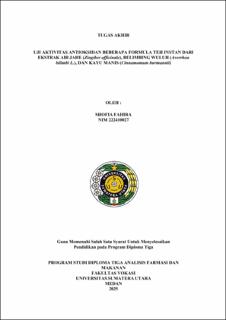| dc.description.abstract | Background : Tea is a beverage that has established itself as a fundamental aspect of
daily life and ranks among the most favored drinks globally, including in Indonesia. Tea
beverages offer a range of advantages, such as lowering the risk of cancer, combating
aging, preventing coronary heart disease, and decreasing cholesterol levels. Tea is
recognized for its health benefits due to the presence of bioactive compounds that function
as antioxidants, aiding in the inhibition of free radical activity that can harm the body.
Tea can also be prepared using a range of other ingredients derived from different parts
of the plant, commonly referred to as instant tea. Ginger is a botanical that is rich in
antioxidants. Ginger beverages demonstrate enhancements in immune system function.
The constituents of starfruit leaves serve as antioxidants, effectively neutralizing free
radicals in the body that may lead to various diseases. Cinnamon comprises chemical
compounds such as phenols, terpenoids, and saponins, which serve as sources of
antioxidants. An alternative method to harness the benefits of various plant materials rich
in natural antioxidants is to process them into powdered drink formulations.
Objective : The objective is to assess the antioxidant activity of instant tea derived from
ginger, starfruit, and cinnamon in various formulations.
Method : The antioxidant activity of ginger, starfruit, and cinnamon instant tea was tested
using the DPPH (1,1-diphenyl-2-picrylhydrazyl) method with a UV-Visible
spectrophotometer.
Results : The instant tea regression equation F1 is y = 0.0983x + 45.918 with a correlation
coefficient value of 0,9216; F2 is y = 0.3123x – 0.7 with a correlation coefficient value
of 0.9926; F3 is y = 0.2895x – 9.568 with a correlation coefficient value of 0.9948; F4 is
y = 0.3352x – 5.794 with a correlation coefficient value of 0.9586; F5 is y = 0.2265x +
8.199 with a correlation coefficient value of 0.8176 and the quercetin regression equation
is y = 0.7406x – 0.697 with a correlation coefficient value of 0.9865.
Conclusion : Instant tea F1 has an IC50 of 65.9901 µg/ml which is categorized as strong;
F2 has an IC50 of 161.6080 µg/ml which is categorized as weak; F3 has an IC50 of
246.6378 µg/ml which is categorized as very weak; F4 has an IC50 of 287.5846 µg/ml
which is categorized as very weak; F5 has an IC50 of 69.5768 µg/ml which is categorized
as strong; Quercetin has an IC50 of 4.1598 µg/ml which is categorized as very strong. | en_US |


